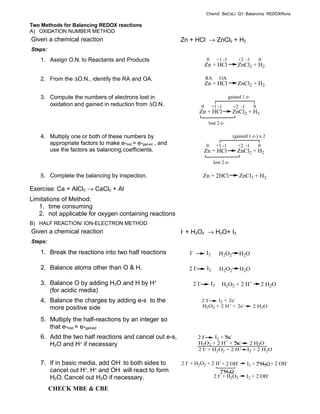
Two Methods for Balancing REDOX Reactions
- 1. Chem2_BeCsLi_Q1: Balancing_REDOXRxns Two Methods for Balancing REDOX reactions A) OXIDATION NUMBER METHOD Given a chemical reaction Zn + HCl → ZnCl2 + H2 Steps: 1. Assign O.N. to Reactants and Products 0 +1 -1 +2 -1 0 Zn + HCl ZnCl2 + H2 2. From the ∆O.N., identify the RA and OA. RA OA Zn + HCl ZnCl2 + H2 3. Compute the numbers of electrons lost in gained 1 e- oxidation and gained in reduction from ∆O.N. 0 +1 -1 +2 -1 0 Zn + HCl ZnCl2 + H2 lost 2 e- 4. Multiply one or both of these numbers by (gained 1 e-) x 2 appropriate factors to make e-lost = e-gained , and 0 +1 -1 +2 -1 0 use the factors as balancing coefficients. Zn + HCl ZnCl2 + H2 lost 2 e- 5. Complete the balancing by inspection. Zn + 2HCl ZnCl2 + H2 Exercise: Ca + AlCl3 → CaCl2 + Al Limitations of Method: 1. time consuming 2. not applicable for oxygen containing reactions B) HALF REACTION/ ION-ELECTRON METHOD Given a chemical reaction I- + H2O2 → H2O+ I2 Steps: 1. Break the reactions into two half reactions I- I2 H2O2 H 2O 2. Balance atoms other than O & H. 2 I- I2 H2O2 H2O 3. Balance O by adding H2O and H by H+ 2 I- I2 H2O2 + 2 H+ 2 H2O (for acidic media) 4. Balance the charges by adding e-s to the 2 I- I2 + 2e- more positive side H2O2 + 2 H+ + 2e- 2 H2O 5. Multiply the half-reactions by an integer so that e-lost = e-gained 6. Add the two half reactions and cancel out e-s, 2 I- I2 + 2e- H2O and H+ if necessary H2O2 + 2 H+ + 2e- 2 H2O 2 I- + H2O2 + 2 H+ I2 + 2 H2O 7. If in basic media, add OH- to both sides to 2 I- + H2O2 + 2 H++ 2 OH- I2 + 2 H2O + 2 OH- cancel out H+. H+ and OH- will react to form 2 H2O H2O. Cancel out H2O if necessary. 2 I- + H2O2 I2 + 2 OH- CHECK MBE & CBE
- 2. Chem2_BeCsLi_Q1: Balancing_REDOXRxns Balance the following reactions using ion-electron method. 1. Cr2O72- + I- Cr3+ + I2 (acidic) 2. MnO42- MnO41- + MnO2 (acidic) 3. NH3 + O2 NO + H2O (basic) 4. HNO3 + H2S S+ NO (acidic) 5. Pb + PbO2 + H2SO4 PbSO4 (acidic) 6 MnO41- + SO2 Mn2+ + SO42- (acidic)